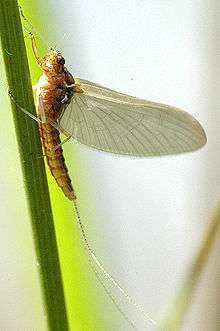Caenis (mayfly)
| Caenis | |
|---|---|
 | |
| Caenis horaria | |
| Scientific classification | |
| Kingdom: | Animalia |
| Phylum: | Arthropoda |
| Class: | Insecta |
| Order: | Ephemeroptera |
| Suborder: | Pannota |
| Superfamily: | Ephemerelloidea |
| Family: | Caenidae |
| Genus: | Caenis Stephens, 1835 |
Caenis is a genus of mayflies. They are very small in size, sometimes with a body of only an 1/8 of an inch (3.2 mm).
Distribution and ecology
Caenis is one of the most abundant mayfly genera of the Holarctic. Larvae can occur in high densities on the bottoms of shallow ponds and lakes up to an altitude of 1800 meters in the [Alps].[1]
Densities of 700-1700 larvae per square meter have been reported for C. luctuosa and C. horaria on bottoms covered with organic detritus or decaying leaves. Densities on mineral sediments are an order of magnitude lower (4-330 animals per square meter).[2]
Species
- Caenis amica Hagen, 1861
- Caenis anceps Traver, 1935
- Caenis arwini
- Caenis bajaensis Allen & Murvosh, 1983
- Caenis candida
- Caenis diminuta Walker, 1853
- Caenis hilaris (Say, 1839)
- Caenis horaria (Linnaeus, 1758)
- Caenis latipennis Banks, 1907
- Caenis luctuosa (Burmeister, 1839)
- Caenis macafferti
- Caenis punctata McDunnough, 1931
- Caenis tardata
- Caenis youngi Roemhild, 1984
Varia
Imitations of this mayfly in hook sizes as small as # 28 are used for fly-fishing.[3] Tying fly imitations this small is difficult, hence the nickname "Anglers Curse."
References
| Wikispecies has information related to Caenis |
- ↑ Menetrey, N; B Oertli; M Sartori; A Wagner; JB Lachavanne (2008). "Eutrophication: are mayflies (Ephemeroptera) good bioindicators for ponds?". Hydrobiologia. 597 (1): 125–135. doi:10.1007/s10750-007-9223-x.
- ↑ Int Panis, L; Bervoets L; Verheyen RF (1995). "The spatial distribution of Caenis horaria (L., 1758)(Caenidae, Ephemeroptera) in a pond in Niel (Belgium)". Bull. Annls Soc. belge Ent. 131: 47–51.
- ↑ Jason Neuswanger. "Mayfly Genus Caenis (Angler's Curses)". Troutnut.com. Retrieved 30 December 2014.
This article is issued from
Wikipedia.
The text is licensed under Creative Commons - Attribution - Sharealike.
Additional terms may apply for the media files.